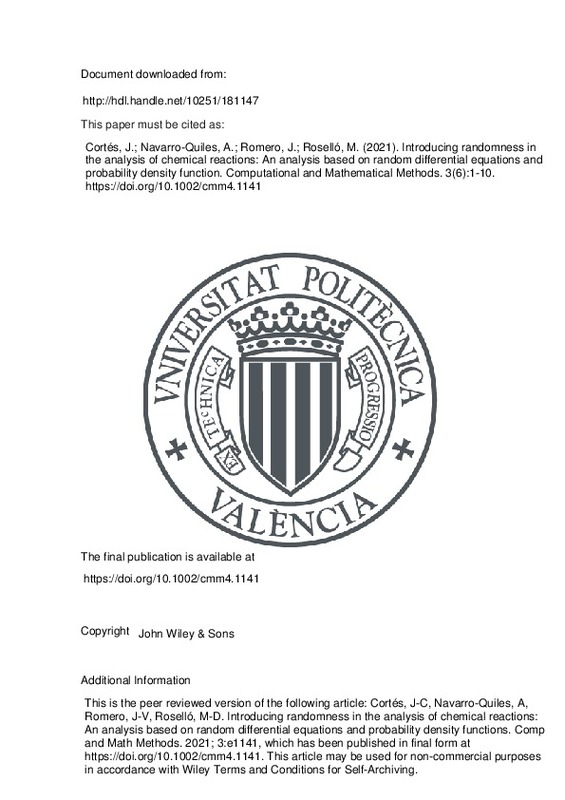JavaScript is disabled for your browser. Some features of this site may not work without it.
Buscar en RiuNet
Listar
Mi cuenta
Estadísticas
Ayuda RiuNet
Admin. UPV
Introducing randomness in the analysis of chemical reactions: An analysis based on random differential equations and probability density function
Mostrar el registro sencillo del ítem
Ficheros en el ítem
| dc.contributor.author | Cortés, J.-C.
|
es_ES |
| dc.contributor.author | Navarro-Quiles, Ana
|
es_ES |
| dc.contributor.author | Romero, José-Vicente
|
es_ES |
| dc.contributor.author | Roselló, María-Dolores
|
es_ES |
| dc.date.accessioned | 2022-02-28T19:03:19Z | |
| dc.date.available | 2022-02-28T19:03:19Z | |
| dc.date.issued | 2021-11 | es_ES |
| dc.identifier.uri | http://hdl.handle.net/10251/181147 | |
| dc.description | This is the peer reviewed version of the following article: Cortés, J-C, Navarro-Quiles, A, Romero, J-V, Roselló, M-D. Introducing randomness in the analysis of chemical reactions: An analysis based on random differential equations and probability density functions. Comp and Math Methods. 2021; 3:e1141, which has been published in final form at https://doi.org/10.1002/cmm4.1141. This article may be used for non-commercial purposes in accordance with Wiley Terms and Conditions for Self-Archiving. | es_ES |
| dc.description.abstract | [EN] In this work we consider a particular randomized kinetic model for reaction-deactivation of hydrogen peroxide decomposition. We apply the Random Variable Transformation technique to obtain the first probability density function of the solution stochastic process under general conditions. From the rst probability density function, we can obtain fundamental statistical information, such as the mean and the variance of the solution, at every instant time. The transformation considered in the application of the Random Variable Transformation technique is not unique. Then, the first probability density function can take different expressions, although essentially equivalent in terms of computing probabilistic information. To motivate this fact, we consider in our analysis two different mappings. Several numerical examples show the capability of our approach and of the obtained results as well. We show, through simulations, that the choice of the transformation, that permits computing the first probability density function, is a crucial issue regarding the computational time. | es_ES |
| dc.description.sponsorship | This work has been supported by the Spanish Ministerio de Economía, Industria y Competitividad (MINECO), the Agencia Estatal de Investigación (AEI) and Fondo Europeo de Desarrollo Regional (FEDER UE) grant MTM2017-89664-P. Computations have been carried thanks to the collaboration of Raúl San Julián Garcés and Elena López Navarro granted by European Union through the Operational Program of the European Regional Development Fund (ERDF)/European Social Fund (ESF) of the Valencian Community 2014-2020, grants GJIDI/2018/A/009 and GJIDI/2018/A/010, respectively. | es_ES |
| dc.language | Inglés | es_ES |
| dc.publisher | John Wiley & Sons | es_ES |
| dc.relation.ispartof | Computational and Mathematical Methods | es_ES |
| dc.rights | Reserva de todos los derechos | es_ES |
| dc.subject | Chemical kinetic model | es_ES |
| dc.subject | First probability density function | es_ES |
| dc.subject | Random model | es_ES |
| dc.subject | Random variable transformation technique | es_ES |
| dc.subject.classification | MATEMATICA APLICADA | es_ES |
| dc.title | Introducing randomness in the analysis of chemical reactions: An analysis based on random differential equations and probability density function | es_ES |
| dc.type | Artículo | es_ES |
| dc.identifier.doi | 10.1002/cmm4.1141 | es_ES |
| dc.relation.projectID | info:eu-repo/grantAgreement/AEI/Plan Estatal de Investigación Científica y Técnica y de Innovación 2013-2016/MTM2017-89664-P/ES/PROBLEMAS DINAMICOS CON INCERTIDUMBRE SIMULABLE: MODELIZACION MATEMATICA, ANALISIS, COMPUTACION Y APLICACIONES/ | es_ES |
| dc.relation.projectID | info:eu-repo/grantAgreement/GVA//GJIDI%2F2018%2FA%2F009/ | es_ES |
| dc.relation.projectID | info:eu-repo/grantAgreement/GVA//GJIDI%2F2018%2FA%2F010/ | es_ES |
| dc.rights.accessRights | Abierto | es_ES |
| dc.contributor.affiliation | Universitat Politècnica de València. Departamento de Matemática Aplicada - Departament de Matemàtica Aplicada | es_ES |
| dc.description.bibliographicCitation | Cortés, J.; Navarro-Quiles, A.; Romero, J.; Roselló, M. (2021). Introducing randomness in the analysis of chemical reactions: An analysis based on random differential equations and probability density function. Computational and Mathematical Methods. 3(6):1-10. https://doi.org/10.1002/cmm4.1141 | es_ES |
| dc.description.accrualMethod | S | es_ES |
| dc.relation.publisherversion | https://doi.org/10.1002/cmm4.1141 | es_ES |
| dc.description.upvformatpinicio | 1 | es_ES |
| dc.description.upvformatpfin | 10 | es_ES |
| dc.type.version | info:eu-repo/semantics/publishedVersion | es_ES |
| dc.description.volume | 3 | es_ES |
| dc.description.issue | 6 | es_ES |
| dc.identifier.eissn | 2577-7408 | es_ES |
| dc.relation.pasarela | S\423304 | es_ES |
| dc.contributor.funder | Generalitat Valenciana | es_ES |
| dc.contributor.funder | AGENCIA ESTATAL DE INVESTIGACION | es_ES |
| dc.contributor.funder | European Regional Development Fund | es_ES |







![[Cerrado]](/themes/UPV/images/candado.png)

